Commander Showdown — Ayli vs Karlov

The Great Divide
If you browse the pages of EDHREC enough, you might notice a gap between the most-played and second-most-played commander in any given color identity. In Gruul, for example, Omnath, Locus of Rage has 1343 decks, while the next highest, Xenagos, God of Revels, has 909. In Azorius, the difference between Brago, King Eternal and Grand Arbiter Augustin IV is more than 600. And in Golgari, Meren of Clan Nel Toth touts a whopping 2100 decks to The Gitrog Monster's 928.
These gaps are fascinating, but not as fascinating as the commanders with almost no gap at all. Often, the larger the number between two commanders, the more dissimilar they are, and the smaller the number, the more alike they are. Meren and The Gitrog Monster both enjoy graveyards, but in very different ways. Meanwhile, Trostani, Selesnya's Voice and Rhys the Redeemed have less than a 50 deck difference between them, and they're so similar I wrote the first Commander Showdown about them.
With all this in mind, let's turn our attention to a pair of commanders with a difference of only 21 decks. Both are heralds of lifegain, the most popular strategy in their color pair, and both can exile their opponents' cards with ease if that lifegain goes unchecked. It's time for a showdown between Ayli, Eternal Pilgrim and Karlov of the Ghost Council.
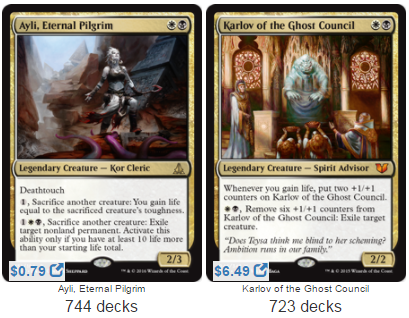
It's a Wonderful Lifegain
We met Uncle Karl back in Commander 2015, in the "Call the Spirits" precon. That deck was more tuned to run its other commander, Daxos the Returned, but Karlov has proven to be more popular, and it's not hard to see why. Every time you gain life, Karlov gets a bit stronger. That strength can then be traded in for an amazing ability: exile target creature. Any creature. If you gain life three times, you have an Unmake charged and ready.
Karlov is also only two mana, which makes him very deadly. Since he hits the battlefield on turn two, he has many opportunities to see lifegain triggers. A turn-one Soul Warden into a turn-two Karlov means you might be attacking for 8 commander damage on turn three. If an opponent plays a creature that you need out of the way, you can reset his power and take your enemies down with you.
Ayli is also only two mana, but she's far less aggressive. First of all, she has deathtouch, a great defensive mechanic. Second, she too has the ability to exile things, but only once a specific threshold has been reached: you must have 10 or more life than your starting life total. That's certainly achievable, especially because Ayli can gain life for you, a thing Karlov certainly can't do. Her abilities come at a cost, though: you must sacrifice your creatures, both to gain life and to exile. Assembling cohorts and gaining life will take a bit more time than Karlov. That extra time is probably worth the wait, though, since Ayli can exile any nonland permanent, while Karlov can only exile creatures.
Alright, enough theory. Let's look at some actual data.
Venn Diagram Time
I made a Venn Diagram below using the Top and Signature Cards of each commander to see which cards they have in common, and which cards they don't. There may be a small gap between the number of decks they have on EDHREC, but the gap between their individual card choices is what's really important. Let's take a look at the results:
The first and most obvious thing to note here is that Ayli's column is quite short. This is because her EDHREC page has a much smaller Signature Cards section. That alone tells us something pretty interesting. Signature Cards are fairly unique to that specific commander, and don't see as much play from other commanders in the same colors. If Ayli has very few unique cards, that means her deck is comprised of the usual suspects. You're likely to encounter familiar Orzhov spells against an Ayli player: Anguished Unmaking and Merciless Eviction, for instance.
So what are those unique cards of hers? If there are so few of them, they must pack a punch.
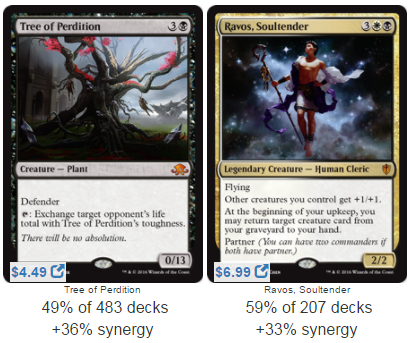
A punch indeed! Tree of Perdition is downright nasty in an Ayli deck. Not only can it take a 27-point chunk out of an opponent's life total, Ayli can also sacrifice it afterward to gain 40 life. That's bananas.
The other three in her column are particularly illuminating: Ravos, Soultender, Sun Titan, and Skullclamp. All three of these cards provide a lot of advantage over the course of a long game. Ravos and Sun Titan revive minions for her to sacrifice, and Skullclamp draws cards for each one she sends to the graveyard. Ayli's deck is decidedly gradual, not just because her abilities require setup, but because they're powerful enough to remove anything in her way.
Contrast those cards against Karlov's column, which is packed full of lifegain, lifegain, lifegain. Ayli likes lifegain, but only enough to enable her powers. Gaining life is a means to an end in her deck, not an end unto itself. If need be, she'll gain the life she wants herself, and would rather spend slots in her deck that provide a lot of power than a lot of life. Case in point, Soul Warden and Kambal, Consul of Allocation may appear in the “Both” column, but Soul's Attendant and Authority of the Consuls do not. They show up in Karlov's column, since he's hyper-invested in cards that provide him lots and lots of lifegain triggers. He doesn't care how much life you gain, just how often you gain it.
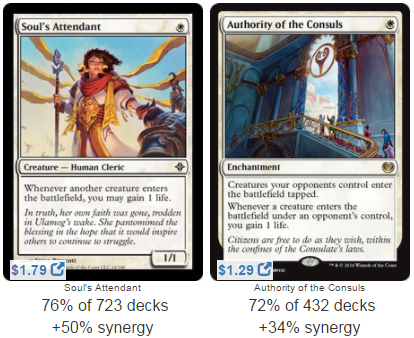
Cards like these, which power up Karlov to immense heights, demonstrate his game plan very efficiently: Karlov weaponizes lifegain by turning himself into a Voltron. He can easily get to a power level that allows him to one-shot his opponents. A sly Rogue's Passage sits in his column for that exact reason. However, this also means Karlov has many of the same weaknesses as other aggressive Voltron decks; if he's not protected early, he may fall off a bit in the later half of the game, the half which Ayli very much looks forward to dominating.
I think the two Orzhov partner commanders summarize these two commanders exceptionally well. Ravos, Soultender and Tymna the Weaver each show up as major players in a different one of these decks. Ayli prefers Ravos, who gives her gradual value over a long game that she intends to control and dominate. Karlov would rather enlist Tymna, who draws him extra cards as a reward for his aggressive style.
Eternal Pilgrim vs. the World
Overall, Ayli's column in the Venn Diagram was much too short for us to get a real impression of her, so let's check out an average Ayli deck to see what else we can find.
Average Ayli Deck
View on Archidekt
|
There's a bit of a “Death by a Thousand Cuts” theme going on with this list, what with all these cards that not only gain you life but drain it from your opponents. Gray Merchant of Asphodel, Pontiff of Blight, and Blood Artist can put in a lot of work over a long game, which is exactly her style. I also totally dig the Dictate of Erebos, since Ayli sacrifices so many creatures.
My absolute, hands-down, flat-out favorite card in this list, though, is definitely Hidden Stockpile.
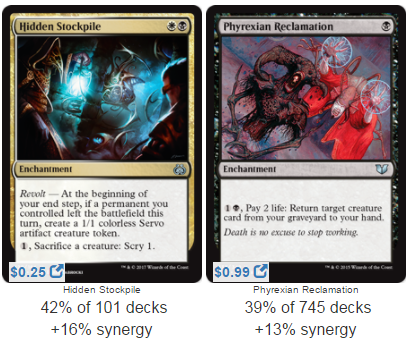
Endless. Supply. Of sac fodder. At the end of each turn you sacrificed a creature, you get another creature to sacrifice. Use them however you desire: scry, gain life, or removal. Exceptionally valuable stuff here.
In fact, there are a lot of goodies here that can provide Ayli with a constant supply of creatures, like Phyrexian Reclamation and Athreos, God of Passage. With these, Ravos, and a few other cards, there's a bit of a reanimator undercurrent happening in Ayli decks, and that's pretty wonderful.
What about Karlov?
Uncle Karl
The Venn Diagram showed off a lot of Karlov's strengths, but a sample decklist might show us how his deck deals with his weaknesses.
Average Karlov Deck
View on ArchidektThere are some pretty obvious ones up there: Aetherflux Reservoir and the infamous Felidar Guardian are staples of any lifegain strategy. The Sanguine Bond + Exquisite Blood combo is also a huge game-ender, as any shift in life, even one point, can win you the game.
The ones that catch my eye, though, are Debt to the Deathless and Exsanguinate.
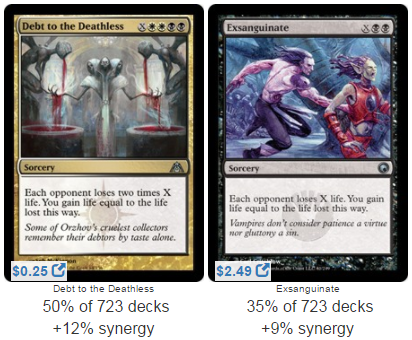
These cards are probably the greatest nod to Karlov's weakness in the deck, and do an excellent job of shoring up that weakness. Remember, Karlov doesn't care how much life you gain. Whether you gain three life or three hundred, he'll still only get two +1/+1 counters. So for cards like Debt to the Deathless to show up in his deck, which cost a lot of mana for only two +1/+1 counters, they better be serious business. Well, ask anyone who's lost to one of these cards and they'll tell you: they are. These cards are excellent finishers. If Karlov doesn't clinch victory through his commander damage, he still has his outs. Your opponents had better keep track on their diminishing life total just as much as they keep an eye on your growing one.
Cards to Consider
Finally, I'd like to mention a few cards that I think could stand to see more play in both of these decks.
Ayli
- Palace Siege. If Ayli likes Ravos, she should like this card too. Whether you need to drain life or you'd like to get your sac fodder back, this enchantment will give you a lot of staying power. It should definitely see more play than just 22% of Ayli decks.
- Peregrine Mask. This is kind of cheeky, but I think we'd be remiss to forget Ayli's natural deathtouch. If you don't want to be attacked, this is a great way to guarantee it. While you're at it, why not make her a pinger? Thornbite Staff or Viridian Longbow could come in handy. Use her deathtouch to take care of enemy creatures, and her other ability to take care of noncreature permanents.
- Reassembling Skeleton. I'm pretty surprised this only shows up in 23% of Ayli decks. Ol' Skelly here can revive itself at instant speed, meaning you always have an emergency sac fodder at the ready. It's much faster than Phyrexian Reclamation and Ravos, and those both see much more play.
- Is it just me, or does Angelic Accord seems bonkers once you get it going? Once you get an angel, you can sacrifice it to gain four life… and another angel… and then four more life… and another angel…
- Mimic Vat. I've recommended this card before, and I'll recommend it again. I think this is sneaky powerful in an Ayli deck. If an awesome creature dies, you can steal it, use it to beat down on your opponents, and sacrifice it to gain the life you need. If nothing else, it's another method of obtaining instant-speed sacrifice fodder, and that seems pretty awesome.
Karlov
- Test of Endurance. This card doesn't show up on Karlov's page at all, or Ayli's, for that matter, and that is just plain wrong. If decks are running Felidar Sovereign, they should know about this card too. This card is seen most in Oloro, Ageless Ascetic decks, at 410 copies, but after that, the next commander that plays it most is Trostani, Selesnya's Voice at 71. That's a gap I don't understand. If you like lifegain, you should at least know this card exists.
- Tablet of the Guilds and Contemplation seem pretty decent here. There are a lot of Angel's Feather and Staff of the Death Magus-type cards out there, but they only hit half of your spells, and it's impossible to tell what colors other people will be playing before you sit down at the table, which makes them a bit of a gamble. Tablet of the Guilds and Contemplation, however, are guaranteed hits on nearly every spell you cast. Karlov's deck tends to have low converted mana costs, so you could trigger these twice a turn. If nothing else, I think they're much better than cards like Ajani's Mantra, which sees more play than both of these cards.
- Arcane Lighthouse is just a downright excellent card in general, but it's particularly powerful here. Karlov can only exile creatures, so he'll need some extra help if he's going to knock out someone else's hexproof commander. Arcane Lighthouse is just the key he needs to make sure his enemies can't hide.
- Maybe this is a little “win-more,” but Essence Harvest looks hysterical to me. Karlov can grow to ridiculous proportions, but without any natural trample or evasion, it can be very difficult for him to break through enemy defenses. Essence Harvest means you don't have to. It doesn't even target him, so you can still cast it if Karlov has shroud. I just think it sounds awesome to dome someone for 22 when they think they're untouchable.
- Finally, Moonlit Wake is a pretty cool gem that doesn't show up on Karlov's page at all, but totally fits his style. If Blood Artist is seeing play in over half of Karlov decks, this un-Murder-able enchantment version should be a consideration as well. It doesn't drain life, but who cares? It's the lifegain trigger you're after.
The Circle of Lifegain
Even if the gap between Ayli's decks and Karlov's is a small number, the gap between their strategies is pretty wide. Though both use lifegain, one uses it to control the board, while the other uses it to mount a powerful attack. Keep a watchful eye out for both of these commanders if they're across the table from you. Each of them loves life--just not yours.
Til next time!
EDHREC Code of Conduct